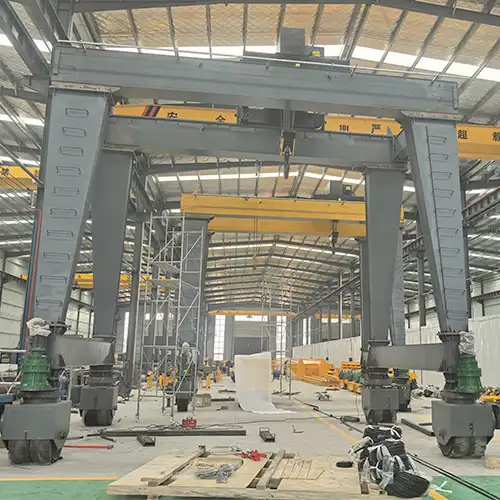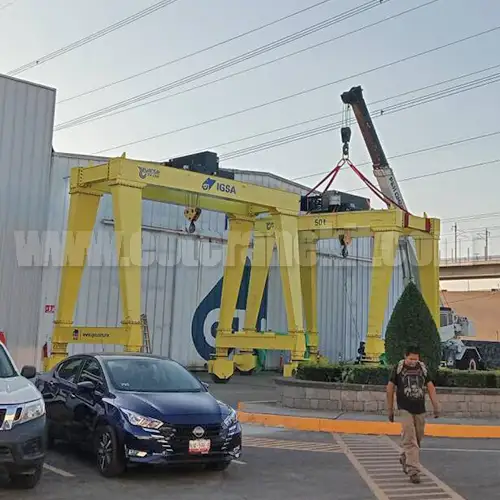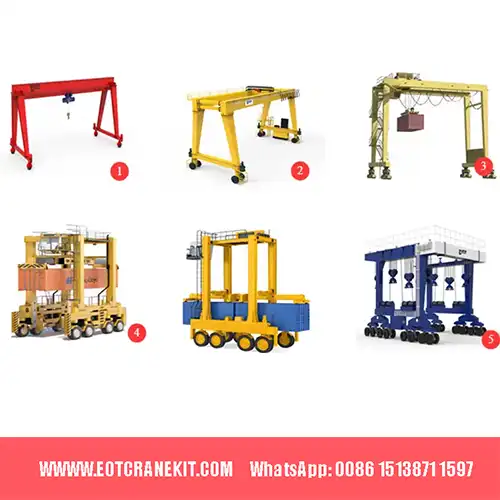30 Ton & 50 Ton RTG Gantry Cranes with Affordable European Hoists
Reliable RTG gantry cranes with 30 and 50-ton European style hoists deliver efficient, safe heavy lifting in industrial yards.Get rubber tyred gantry crane.
Category: Featured
Your Trusted Rubber Tyred Gantry Crane Manufacturer & Supplier
Rubber Tyred Gantry Crane Case Study
30 Ton & 50 Ton RTG Gantry Crane Equipped with European Style Hoists for Heavy Lifting Operations
Introduction
RTG gantry cranes are widely used in ports, container yards, and industrial sites where heavy lifting and high mobility are essential. These cranes run on rubber tires, allowing them to move smoothly over large areas without the need for fixed rails. Because of this mobility, RTG gantry cranes are a popular choice for handling bulky and heavy loads, especially containers and large steel structures.
One of the critical components of an RTG gantry crane is the hoist mechanism. European style hoists have become a preferred option for RTG cranes due to their robust design, reliability, and precise control. These hoists can handle heavy loads efficiently, which matches well with the demanding operational conditions of RTG cranes.
This case study focuses on the integration of RTG gantry cranes equipped with high-capacity European style hoists. We will explore the technical details, design considerations, and operational benefits of combining these two elements. The goal is to provide a clear understanding of how this combination supports heavy-duty lifting needs in challenging environments.
Key Points Covered in This Section:
- What RTG gantry cranes are and where they are used
- Why European style hoists are suitable for RTG cranes
Challenges addressed by this solution include:
- Handling heavy loads without compromising mobility on uneven ground
- Ensuring the hoists provide smooth, controlled lifting and lowering of heavy cargo
- Meeting strict safety standards while maximizing uptime in a demanding work environment
Using RTG gantry cranes combined with reliable European style hoists proved to be an effective way to meet these challenges head-on.
Case- Technical Specifications of RTG Gantry Crane and Hoists
The RTG gantry cranes designed for this project come with specific technical features to meet operational demands.
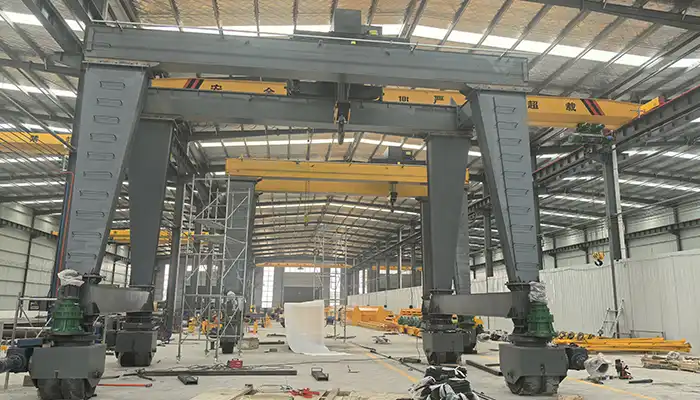
RTG Gantry Crane Key Parameters:
- Crane Type: double girder rubber tyred gantry crane with European style electric hoist trolley
- Crane Capacity; 30 Ton and 50 Ton.
- Span: 6 meters — compact enough for tight spaces but wide enough for efficient handling
- Hook Height: 6 meters — suitable for stacking and moving containers or steel plates safely
- Mobility: Equipped with rubber tires that allow easy movement across container yards or industrial sites without rails, providing flexibility in operations
- Gantry Hoist Details: Two types of European style hoists were selected to match different lifting needs.
- Electrical Supply for the RTG Gantry Crane System:Voltage: 440V, Frequency: 60Hz, Phase: 3-phase power supply. The electrical system is designed to provide stable power for both crane movement and hoist operation, ensuring smooth and efficient lifting performance
Design and Engineering Integration
Integrating European style hoists into RTG gantry cranes requires careful engineering and design to ensure the entire system works smoothly and safely under heavy loads.
Engineering Approach for Mounting European Style Hoists
Mounting European style electric wire rope hoists on an RTG gantry crane is not just about attaching the hoist to the crane structure. It involves:
- Precise alignment: The hoist must be positioned exactly to balance the load and prevent undue stress on the crane frame.
- Load distribution: Engineering calculations ensure the hoist's weight and the lifted load are evenly distributed to avoid structural weaknesses.
- Vibration control: Since RTG cranes operate on rubber tires and uneven surfaces, the hoist mounting design includes vibration dampers to reduce wear and improve operational stability.
- Accessibility: The design ensures easy access for maintenance and inspections without requiring disassembly of major crane components.
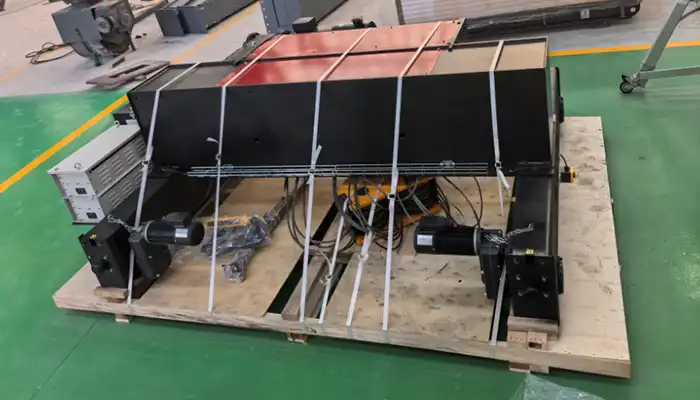
Electrical System Compatibility and Power Supply Integration
A reliable electrical system is essential for the smooth operation of both the RTG gantry crane and the European style hoists. Key points include:
- Power supply: The system is designed for a 440V, 60Hz, 3-phase power source, common in industrial settings, ensuring stable voltage for motors and controls.
- Electrical integration: Control panels and wiring are engineered to coordinate crane movement and hoist lifting functions seamlessly.
- Safety features: Overload protection, emergency stops, and fault detection systems are built in to protect both the crane and operators.
- Energy efficiency: Modern drives and control systems optimize power consumption, reducing operational costs and heat generation.
Compliance with Safety Standards Including 6M Hoist Classification
Safety is a top priority in crane design, especially for heavy lifting RTG gantry cranes. Compliance includes:
- 6M classification: This denotes a hoist designed for heavy-duty service with frequent starts and stops, capable of handling tough industrial conditions reliably.
- International standards: The entire crane and hoist system meet relevant safety codes such as ISO, FEM, or ANSI/ASME, depending on the project location.
- Regular testing: Structural integrity, load capacity, and electrical safety are verified through load tests and inspections before commissioning.
- Operator safety: Design includes features like clear visibility, safe walkways, and ergonomic controls to reduce accident risk during operation.

Structural Design Considerations Specific to RTG Gantry Cranes
RTG gantry cranes have unique structural demands compared to rail-mounted cranes. Key considerations include:
- Rubber-tyred mobility: The crane structure must handle dynamic loads caused by movement on uneven ground without excessive stress or deformation.
- Frame rigidity: The gantry frame needs to be strong enough to support heavy hoists and loads while resisting bending or twisting.
- Weight optimization: To maintain mobility, the crane's structure is designed to be robust but not excessively heavy, balancing strength and maneuverability.
- Span and height constraints: The 6-meter span and hook height dictate beam sizes and support structures to provide safe lifting clearance without sacrificing crane stability.
This detailed approach ensures the RTG gantry crane with European style hoists operates efficiently, safely, and reliably in demanding environments.
Factory Testing Video on RTG Gantry CRANE
Before an RTG gantry crane leaves the factory, thorough testing is essential to make sure it operates safely and meets all performance standards. Testing covers the crane's control systems, travelling functions, steering, and load-handling capabilities.
Testing of Crane Control Systems
- The crane's control system is tested to ensure all commands from the operator are accurately executed.
- Tests include start, stop, speed control, and emergency stop functions under various load conditions.
- The interface, whether wired or wireless, is checked for responsiveness and reliability.
- Safety interlocks and alarms are verified to prevent unsafe operations.
- Control logic is simulated to ensure the crane responds correctly in different scenarios, such as overload or power failure.
Testing of Crane Travelling with Wireless Remote Control
- RTG gantry cranes often use wireless remote controls to improve operator flexibility and safety.
- The remote control's range and signal strength are tested across the full operating area to prevent communication dropouts.
- All movement commands — forward, backward, speed changes — are verified for smooth and precise control.
- Response time between remote command and crane action is measured to ensure minimal delay.
- Tests are conducted in environments simulating actual yard conditions to confirm reliability.
Testing of Crane Travelling and Steering
- Travelling tests assess the RTG crane's ability to move on rubber tires over different surface conditions.
- The crane is driven through turns and maneuvers to test steering systems, ensuring tight turning radii and stable motion.
- Acceleration and braking performance are checked to confirm smooth operation without jolts.
- Tests include verifying the synchronization between travelling and steering controls to prevent drift or misalignment.
- Safety features such as speed limits and obstacle detection during travel are validated.
Load Testing of RTG Gantry Crane
- Load tests are critical to verify the crane's lifting capacity and structural strength.
- The crane is tested lifting loads at 100% of its rated capacity (30 tons and 50 tons for this project) and often at 125% for safety verification.
- Multiple lifting cycles are performed to simulate real working conditions.
- Load sway and stability are monitored to ensure secure handling.
- During load tests, hoist braking, emergency stop, and overload protection systems are checked for proper function.
- After load testing, structural inspections are carried out to detect any signs of stress or deformation.
These factory tests ensure the RTG gantry crane and its European style hoists work smoothly together and meet all operational and safety standards before delivery.
Operational Performance and Benefits
The RTG gantry crane system equipped with European style hoists has demonstrated solid performance across lifting, speed, and efficiency metrics in real-world operations.
Lifting Performance, Speed, and Efficiency
- The cranes consistently handle their rated capacities of 30 and 50 tons without strain, maintaining smooth and controlled lifts.
- Hoist speed adjustments allow operators to fine-tune lifting and lowering to match load requirements, improving cycle times.
- The mobility of the RTG gantry crane ensures quick repositioning around the yard, minimizing downtime between lifts.
- Energy-efficient motors and controls help reduce power consumption during frequent starts and stops, lowering operating costs.
Operational Advantages of European Style Hoists
- Durability: Built with high-quality materials and designed for heavy-duty use, these hoists resist wear even under tough conditions.
- Precision Control: Smooth hoisting and lowering with minimal load swing improves safety and reduces the risk of damage.
- Ease of Maintenance: Modular components and easy access points simplify routine maintenance, reducing crane downtime.
- Compatibility: Designed to integrate well with RTG cranes, they provide reliable performance in a mobile environment.
Feedback from Operators and Maintenance Teams
- Operators appreciate the responsive controls and the stable handling of loads, which reduces fatigue and increases productivity.
- Maintenance teams report straightforward servicing processes, with fewer unexpected repairs compared to older hoist models.
- Overall, the combination of RTG gantry cranes and European hoists has enhanced operational reliability and safety.
Challenges Faced and Engineering Solutions
While the project was successful, several challenges emerged that required targeted engineering solutions.
Challenges Related to RTG Gantry Crane Mobility and Hoist Integration
- Operating on uneven surfaces caused vibrations that could affect hoist performance if not properly managed.
- Power supply fluctuations in outdoor environments sometimes impacted control system stability.
- Designing a mounting solution that balanced hoist weight and crane mobility without adding excessive structural load.
Solutions Implemented
- Installed vibration dampers and shock absorbers on hoist mounts to reduce mechanical stress and prolong component life.
- Upgraded power systems with voltage stabilizers and surge protectors to ensure smooth electrical supply.
- Used lightweight yet strong materials for structural supports to maintain crane agility while securely mounting heavy hoists.
- Implemented advanced control algorithms that compensate for minor power variations and maintain consistent crane operation.
Conclusion
The deployment of the RTG gantry crane equipped with European style hoists proved to be a solid success. The cranes met the client's lifting and mobility requirements while maintaining high standards of safety and reliability throughout operations.
Operational improvements were clearly noticeable. The cranes handled heavy loads smoothly, moved efficiently across the yard, and reduced downtime thanks to precise hoisting and simple maintenance routines. The client expressed satisfaction not only with the performance but also with the overall system's durability and ease of use.
For anyone looking to select and integrate hoists on RTG gantry cranes, some best practices stand out:
- Choose hoists designed for heavy-duty, frequent use, like those with H6M classification.
- Ensure proper engineering integration to balance structural strength and mobility.
- Pay close attention to electrical compatibility and power supply stability.
- Include vibration mitigation measures to protect both crane and hoist components.
- Involve operators and maintenance teams early to address practical usability and serviceability needs.
Related Products
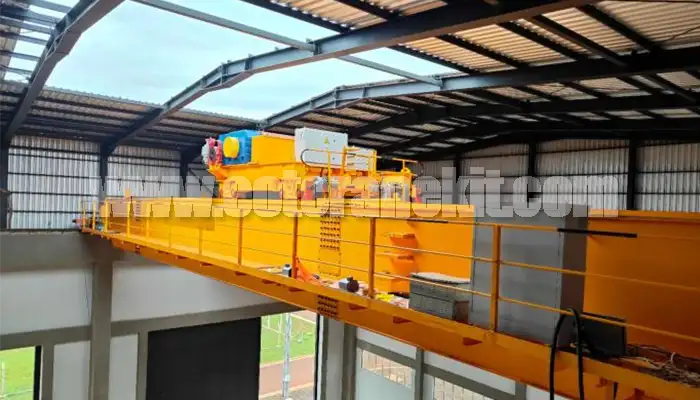
Latest project
150 Ton Overhead Crane Installation Feedback – Paraguay Case
QDX 150 ton overhead crane in action in Paraguay. Installation photos, video, and client feedback show performance, safety, and heavy-lifting efficiency.
Free consultation to Confirm Parameters & Specifications and Get
Latest Crane Price & Crane Rate.
- Types of overhead cranes : _______?
- Optional: Overhead travelling crane, goliath gantry crane,Slewing jib crane, Single girder or double girder crane,small portable crane or kbk crane, etc.
- Capacity of overhead crane: _______?
- Optional: 0.25ton, 0.5 ton, 1 ton, 2 ton, 3ton, 5 ton, 10 ton,15ton, 20ton, 25 ton, 30ton,35ton, up to 550ton, etc.
- Crane span & lifting height : _______?
- Crane travelling length : _____?
- Control of overhead crane:_______?
- Optional: pendant/ remote/cabin control
- Voltage supply of overhead crane:_____?
- Eg,: 380V50/60HZ,3Phase or others,etc.
- Application/usage of crane:_______?
- Eg,: Steel mill, ,injection mold, cement,stone, concrete,granite, general manufacturing, etc.
Just leave a message via the contact form and our hoist and crane engineer will contact you with in 24working hours.
Get In Touch
